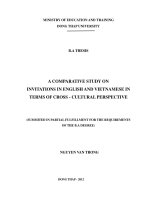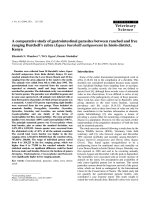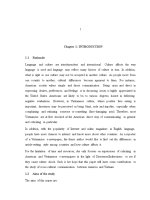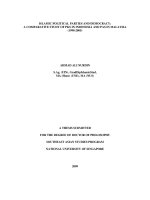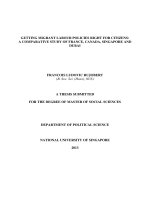A comparative study of criticism between american and vietnamese online newspapers
Bạn đang xem bản rút gọn của tài liệu. Xem và tải ngay bản đầy đủ của tài liệu tại đây (524.54 KB, 37 trang )
1 Chapter 1: INTRODUCTION
1.1 Rationale
Language and culture are interdependent and interactional. Culture affects the way language
is used and language may reflect many factors of culture in turn. In addition, what is right in
one culture may not be accepted in another culture. As people move from one country to
another, cultural differences become apparent to them. For instance, American society values
simple and direct communication. Being open and direct in expressing desires, preferences,
and feelings or in discussing issues is highly appreciated in the United States. Americans are
likely to be, to various degrees, honest in delivering negative evaluations. However, in
Vietnamese culture, where positive face saving is important, directness may be perceived as
being blunt, rude and impolite, especially when complaining and criticizing someone or
something (face-damaging acts). Therefore, most Vietnamese are at first shocked at the
American direct way of communicating in general and criticizing in particular.
In addition, with the popularity of Internet and online magazines in English language, people
have more chances to interact and know more about other countries. As a reporter of a
Vietnamese e-newspaper, the thesis author would like to find out the differences in article-
writing style among countries and how culture affects it.
For the limitation of time and resources, she only focuses on expressions of criticizing in
American and Vietnamese e-newspapers in the light of Directness/Indirectness to see if they
cause culture shock. Such is her hope that this paper will have some contributions to the
study of cross-cultural communication between America and Vietnam.
1.2 Aims of the study
The aims of this paper are:
+ To study cultural aspects which affect criticism in American and Vietnamese online
newspapers
+ To compare the use of directness and indirectness in criticism between American and
Vietnamese online newspapers
1
+ To study ways to express criticism in American and Vietnamese online newspapers
1.3 Scope of the study
This research only analyzes the degree of directness and indirectness in criticism of some
selected American and Vietnamese newspapers.
1.4 Methods of the study
The analysis uses inductive and deductive methods with the following techniques:
+ Selecting some online newspapers with great readership and popularity
+ Collecting and analyzing articles with criticism
+ Consulting reference books
+ Discussing with teachers and friends
+ Conducting surveying
1.5 Designs of the study
Chapter 1: Introduction
Chapter 2: Literature Review
Chapter 3: Criticism in American and Vietnamese e-newspapers
Chapter 4: Data analysis
Chapter 5: Conclusion
2
2 Chapter 2: LITERATURE REVIEW
2.1 Culture
2.1.1 Definition of culture
Culture is one of the most complicated concepts to define. This is partly because of its long
historical development, but mainly because it now has been used in important background
for a lot of distinct intellectual systems.
The word “culture” comes from the Latin root - “colere” which means “to inhabit, cultivate,
or honor”. In other words, it refers to human activities.
In 1952, Kroeber and Kluckhohn compiled a list of over 200 different definitions of culture
in their book “Culture: A critical review of Concepts and Definitions”. One of these is:
“Culture consists of pattern, explicit and implicit, of and for, behavior acquired and
transmitted by symbols, constituting the distinctive achievements of human groups, including
their embodiments in artifacts; the essential core of culture consists of traditional ideas and
especially their attached values; culture systems may, on the other hand, be considered as
products of action, on the other hand as conditioning elements of further actions”
(1952:181)
Because the thesis focuses on the communication aspect of culture, the definition by Levine
and Adelman (cited in Nguyen Quang, 1998) is believed to be the most relevant:
“Culture is a shared background (for example, national, ethnic, religious) resulting from a
common language and communication style, customs, beliefs, attitudes and values. Culture
refers to the informal and often hidden interactions, expressions and viewpoints that people
in one culture share. The hidden nature of culture has been compared to an iceberg, most of
which is hidden under water. Like the iceberg, much of the influence of culture on an
individual cannot be seen. The part of culture that is exposed is not always that which
creates cross-cultural difficulties: the hidden aspects of culture have significant effects on
behaviors and on interactions with other.”
3
2.1.2 Culture shock
Culture shock can be described as the physical and emotional discomfort one suffers when
coming to another country or a place different from the place of origin. Often, the way that
one lived before is not accepted or considered as normal in the new place. Everything is
different, for example, not speaking the language, not knowing how to use some mechanical
systems and so forth.
The symptoms of culture shock can appear at different times. Although one can experience
real pain from culture shock, it is also an opportunity for redefining one’s life objectives. It
is a great opportunity for learning to acquire new perspectives.
In these days, due to the development of technology, people can update information through
media system such as television, newspapers, internet, etc. Another expression of culture
shock occurs when one cannot explain what he/she is viewing. In this case, “culture shock”
may be equivalent to the term “confusion”. For instance, when a foreigner reads this
sentence in a Vietnamese newspaper:
He is considered a Chi in the Vietnamese Literature.
(Ông được coi là anh Chí của nền văn học Việt Nam)
The foreigner is sure to be confused if he does not know Chi and his personality.
In general, culture shock can be described as below:
“A mismatch between the neuro - perceptual - cognitive map and the physical and socio-
cultural environments can cause considerable uncertainty, confusion, insecurity and anxiety.
The complex of thought, emotion and behavior caused by this mismatch is called culture
shock.”
(freedictionary.com/encycopedia/culture-shock)
2.2 Criticism
2.2.1 Definition of criticism
First the definition of critic should be taken into account. A critic (derived from the ancient
Greek word krites meaning a judge) is a person who offers a value judgment or an
interpretation.
4
The term is used in particular for a professional who regularly judges or interprets
performances or other work of other people and publishes these judgments or interpretations
in a periodical (often a newspaper, a magazine, or an academic journal). Critics often
specialize in one field and are usually well educated in that field.
According to Wikipedia online dictionary, “Criticism is the activity of judgment or informed
interpretation and, in many cases, can be synonymous with “analysis”. There are
constructive and destructive criticisms. Constructive criticism is the process of offering valid
and well-reasoned opinions about someone or something, usually involving both positive
and negative comments, in a friendly manner rather than an opposite one. In collaborative
work, this kind of criticism is often a valuable tool in raising and maintaining performance
standards. Destructive criticism is intended to harm someone, derogate and destroy
someone’s creation, prestige, reputation and self-esteem”.
Although there can be both positive and negative aspects to criticism, one sense of the term
emphasizes negative comments. A phrase such as "critics of Einstein argue that..." generally
refers to people who are skeptical of the value of Einstein's position. In a different context,
though, the use of critics in a similar phrase like "critics of Romantic poetry argue that..."
simply means the neutral activity of interpretation.
Written criticism is called a critique - an article or essay that gives a critical evaluation,
serious examination and judgment of something.
Criticism helps to clarify and define the theoretical basis of public address. It also
contributes to setting up a standard of society. In particular, criticism interprets the function
of communication and indicates the limits of present knowledge in society.
2.2.2 Types of criticism
2.2.2.1 Practice of analyzing and evaluating literary or other artistic works
This type of criticism is based on the rules and principles that regulate the practice of the
critic, the art of judging with knowledge and propriety of the beauties and faults of a
literature performance, or of a production in the fine art.
5
As Brande & C. (1913) says the elements of criticism depend on the two principles of
Beauty and Truth, one of which is the final end or object of study it pursuits: Beauty - in
letters and the arts; Truth – in history and sciences.
2.2.2.2 Unfavorable judgment of other social aspects
Unfavorable judgment is called fault - finding or disposal expressed by pointing out faults or
shortcomings. Anyone who does not follow the standard way of doing will be criticized.
This type of criticism covers all aspects of life ranging from politics, economy to social
behaviors.
E.g. The senator received severe criticism from his opponent.
Most people attach a negative connotation to the word criticism because it brings to mind of
something uncomfortable. However, criticism comes into two flavors: constructive and
destructive. Destructive criticism aims to hurt an individual’s self-esteem by causing
psychological damage. In contrast, constructive one is handled with positive attitude that will
receive improved results and give feeling of satisfaction.
Literature criticism requires a certain ability of evaluating literary or artistic works. Also, it
has limited and selected number of readers. Hence, literature criticism is not popular among
people. In contrast, the second type of criticism reflects all the aspects of life and has direct
impact on readers. Thus, the second is the type of criticism the author will focus on in the
next parts.
2.3 Directness vs. Indirectness
2.3.1 An overview of Directness vs. Indirectness
Directness and Indirectness is one of the major categorical dimensions of cross-cultural
communication. This dimension has been seriously studied by many pragmatists, socio-
linguist, etc.
G. Yule (1996) states “whenever there is a direct relationship between a structure and a
function, we have a direct speech act; whenever there is an indirect relationship between a
structure and a function, we have an indirect speech act.”
This statement shows that in direct speech, the speaker/writer says what he means while in
indirect speech, he means more than what he says. In other words, it is easy and clear to
6
understand a direct speech; in contrast, there remain some hints in indirect speech and one
has to know the rules to interpret the meaning.
Americans generally consider themselves to be frank, open and direct in dealing with each
other. They often exhibit strong emotional response to something.
However, according to Althen (2003:18), Americans are often less direct than they realize.
Latins and Arabs are generally inclined to display their emotions more openly than
Americans do and to view Americans as unemotional and cold. Meanwhile, it is believed
that Americans are much more direct than Asians, particularly Vietnamese. As a result,
Vietnamese who appreciate and consider indirectness as politeness will see Americans
insensitive, rude, forceful and sometimes aggressive.
2.3.2 Directness and Indirectness in criticism
A good example of direct criticism would be if the boss told his employee something like:
“How could you make such a stupid mistake? What are you thinking? I don’t know why I
hire you in the first place.”
An American boss tends to criticize this way because it may motivate his employee to work
harder and smarter. This is because being open and direct in expressing opinions, desires,
preferences, and feelings, or in discussing issues, events, and most ideas is considered proper
in the United States.
However, to a Vietnamese worker, it will make him resent and want to quit. It is more
acceptable to say something like:
“Thank you for the report. I can see you put a lot of effort into it. However, I was hoping
you could touch it up a little by summarizing it more carefully and adding some graphs. This
content is solid, but if you could make those small changes, I would really appreciate it.”
The Vietnamese often use hedges before informing bad news or criticizing. Giving some
compliments before showing weak points of others is preferable among them.
2.4 Newspapers
2.4.1 Definition of newspapers
According to Oxford English Dictionary (1990):
7
A newspaper is a sheet of paper printed and distributed, at stated intervals for conveying
intelligence of passing events, advocating opinions, etc.; a public print that circulates news,
advertisements, proceeding of legislative bodies, public announcements, etc.
Another definition that the Levi E. Coe Library presented in their website should be taken
into consideration:
A newspaper is a lightweight and disposable periodical usually printed on low-cost paper
called newsprint containing a journal of current news in a variety of topics. These topics can
include political events, crime, sports, opinion, and weather.
Newspapers are also developed around very narrow topic areas, such as news for merchants
in a specific industry, fans of particular sports, fans of the arts or of specific artists, and
participants in the same sorts of activities or lifestyles.
Most nations have at least one newspaper that circulates throughout the whole country, but
in the United States there are few truly national newspapers, with the exception of USA
Today and The Wall Street Journal; large metropolitan newspapers with expanded
distribution networks such as The New York Times.
Nowadays, newspapers are not only printed on sheets of paper. With the development of
Internet, another kind of newspaper that, in recent years, has been popular to everyone has
appeared: e-newspaper (newspaper in Internet).
2.4.2 E-newspapers
Of all the changes of newspapers, the most significant recent development is obviously the
emergence of the Internet as a second national and global stage for news and entertainment
that can challenge the dominant television. Among other things, it is giving us a growing
industry of journalism and a new tradition of media criticism. This change is taking place
because Internet is the television for print, in the sense that it is allowing writing from many
sources to appear together in the same virtual “space”. That means all the journalism and
media criticism that print makes possible is now available to anyone who can access a
computer, vastly expanding choice and creating all kinds of opportunities, for role modeling,
competition, dialogue, and mutual critique of writers. Now, when there is something wrong,
many of the severe stories and the subsequent critiques are immediately available to millions
of readers, and not merely to a limited audience.
8
Reading e-newspapers obviously has many advantages. First, it is becoming easier and easier
to approach because Internet is so popular today. Second, information is updated everyday,
even every hour. For example, process of football matches is uploaded each minute in
Internet. In addition, people have more chances to choose any kind of newspapers to read
due to their interest and their needs. Furthermore, with the appliance of World Wide Web
(www), people have great opportunities to know and read foreign newspapers. Therefore, the
number of e-newspaper readers has been increasing with high speed.
2.4.3 Language of newspapers
2.4.3.1 Accuracy
Accuracy is required in any written style of language. However, it is particularly important
and significant to newspaper language because newspaper has the function of directing
public opinion. Just a trivial mistake of using wrong words or expressions can make it hard
for readers to understand; and misunderstanding may cause unpredictable serious
consequences.
2.4.3.2 Specification
Another typical feature of newspaper language is specification. Newspapers’ articles provide
specific, concrete details to make readers feel as if they were the insiders, witnessing the
event. As a matter of fact, each event must be fixed at certain time, in certain place, relating
to certain people. This is the basic persuasion because it helps readers check the information
easily.
2.4.3.3 Publicity
Newspaper is a kind of mass media. Every one, regardless of education level, is objectively
served by newspapers where they can both get the information and express their opinion.
Therefore newspapers should use the general standard language to meet the needs of various
readers, so that a scientist with wide knowledge does not feel bored, and a child with low
qualification can easily understand.
2.4.3.4 Conciseness
Language in newspapers should be short and brief. Long expression can make the
information dilute, which causes bad effect on the reception of information. Moreover, it
9
wastes time for both the writers and readers because in this era of information explosion, it is
better to get as much information as possible in the shortest time.
10
3 Chapter 3: CRITICISM IN AMERICAN AND VIETNAMESE NEWSPAPERS
3.1 Major factors affecting direct/indirect criticism
3.1.1 Communication styles
It has been proved that American society values simple, direct verbal and written
communication while the Vietnamese consider directness as lack of subtlety and
sophistication.
Gary M. Wederspahn, a leader in the field of intercultural relations and communications, has
characterized the American style of communication as strongly oriented towards content
(facts, numbers, dates, and precise, explicit meanings). Their speech reflects the high value
they place on words and the need for clarity. Wederspahn (2000) states: “Americans focus
may be compared to a spotlight intensively illuminating a narrow band of the
communication spectrum. In contrast, the communication style in Asia is more like a
floodlight that takes in the context in which the communications occur.” This means the
situation and the relationship of the people involved plus the time and place all carry a large
part of the meaning in the conversation of the Vietnamese. The actual words tend to be less
important and need to be understood in terms of the contextual factors.
3.1.2 Individualism vs. Collectivism
One of the most distinctive characteristics of the American is their devotion to individualism.
They have been trained since very early in their lives to consider themselves as separate
individuals who are responsible for their own situations in life and their own destinies. They
are not socially obliged to see themselves as members of a close-knit, toughly interdependent
family, religious group, tribe, and nation. They have strong belief that all people are of equal
value according to some philosophical or spiritual standard. Their tendencies to use their
boss’s first name, to challenge authority easily, and to expect equal treatment reveal a low
power distance value.
However, such cultures with high power distance as Vietnam frequently take American
individualism and egalitarianism as an unwillingness to show proper deference and respect
to those who deserve it. The Vietnamese always consider themselves as a member of
11
community. They think that people not only live with nature but also live with each other to
establish a society. They are sunk in the relationship with family, morals, laws, politics, etc.
While the American appreciate role of individuals, the Vietnamese value role of community.
The Vietnamese are observed treating people around as kin, as those who come from the
same source, the same origin. This, for thousand years, has been an immutable principle -
individuals are dissolved in community, they are nothing when isolated.
This explains why the Vietnamese pay much attention to the “how” of their communication
so that they do not leave any mistake which damages the relationship between them and
others. Indirectness, especially in criticism, is an effective way to avoid making others feel
unpleasant.
Generally, collectivism vs. individualism leads to two ways of communication. While the
Americans find it comfortable to express their ideas, feelings freely, the Vietnamese have to
take notice of others’ reaction before speaking and writing.
3.1.3 Attitudes towards criticism
According to Wederspahn (2000), the American consider criticism itself a neutral thing
when one starts to use it in order to create a certain experience and feeling. And no one
needs defense against something that is neutral. Additionally, they tend to think of
themselves before taking notice of others’ reactions because of their individualism. For this
reason, the American are not resistant to express their critical opinions.
For the Vietnamese, regardless of how 'true' the criticism is, it seems, for a moment, there is
something wrong with those who are criticized, and seen from the perspective of one’s
personality this is never a pleasant experience. What is not pleasant should be avoided,
diverted, hidden or otherwise be experienced as little as possible. Hence, many of the
activities aim at prevention from being criticized.
3.2 Criticism in American newspapers
As discussed in Chapter 2, the American are generally open and straightforward in
communication. They often speak or write directly about things they dislike. They are not
taught that they should mask their emotional responses. They do not think it improper to
display their feelings.
12
Hence, in American media in general and in American e-newspapers in particular, voice of
criticism is usually strong, straight and direct. Some critical articles even sound aggressive,
severe and sharp.
Most articles of criticism in the US e-newspapers have a very clear style. They give the main
points and state the criticism at the top in the headline and the lead paragraph(s). The body of
the articles then adds details, statements, and comments from people involved in the articles,
plus any background the writer feels necessary to support the criticism more strongly. This
means one gets at least three chances to understand the main points of the article. It is said
“at least” because many articles have accompanying picture and captions (text explaining the
pictures) as well which produce much stronger impact on readers.
The content of the next part is collected and classified through an investigation into three
most popular American online newspapers: USA Today (), The
New York Times (), and The Washington Post
().
3.3 Criticism in Vietnamese newspapers
As regards culture, “Indirectness” is believed to be common in Vietnamese communication.
It is hard for somebody to find a conversation without indirectness or hedges. For instance:
“Tớ biết là cậu rất bận, nhưng khi cậu đi ra ngoài, cậu có thể tiện thể gửi lá thư này cho
mình được không?”
(I know you are busy, but when you go out, will you send this letter for me by the way?)
The phrases as “Tôi đoán là...” (I guess), “Tôi không biết nói ra điều này có phải không,
nhưng...” (I’m not sure if this is right, but...), “Những gì tôi sắp nói có thể sẽ xúc phạm
cậu...” (What I am going to say may offend you...) are examples of hedges and indirectness.
Newspapers reflect the daily life, and are influenced by it. In the essay “Cultural elements in
newspapers” published in “Sai Gon Giai phong” newspaper (The Saigon Liberation) on
February 20, 1999, it is indicated that each article contains many cultural factors such as
ways of thinking, observing, evaluating and writing, which is different from culture to
culture. Therefore, indirectness in Vietnamese newspapers is a matter of course, and the
frequency of indirectness is much higher in case of criticizing.
13
It is well-known that the first and foremost function of newspapers is providing information.
However, if in newspapers, writers only use stereotypes of words and ways of expressing to
report events, or to give out problems, the articles will be so much dull.
In addition, critical articles mention sensitive aspects that may cause unforeseeable reactions
from readers. In daily communication, the Vietnamese tend to avoid straight talks, so do they
in written communication. Therefore, we do not often see direct criticism in Vietnamese
newspapers.
In the most popular websites of e-newspapers such as VnExpress (),
Vietnamnet (), Dân Trí Online (), etc., critical
articles occupy an important position. However, criticism, in comparison with American
newspapers, is still general, light, indirect and not strict, but it is acceptable to Vietnamese
readers.
14


